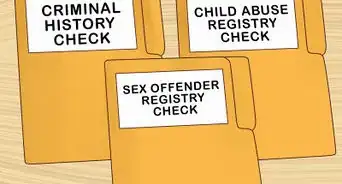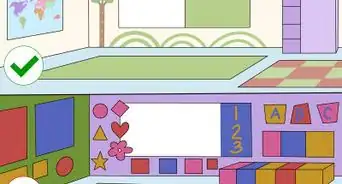This article was co-authored by Iddo DeVries, MA-SLP. Iddo DeVries is a Speech-Language Pathologist and the Owner and Clinical Director of Speech Therapy of DV Therapy, Inc. based in Los Angeles, California since 2014. Focusing on dynamic therapy for individuals and their families, Iddo specializes in family training and speech therapy for disabilities and delays including, autism, late-talkers, PDD, specific language impairments, articulation and phonological disorders, auditory processing delays, stuttering, pragmatic and social delays, Verbal Apraxia of Speech. Iddo holds a BS in Speech Communication Sciences from Brooklyn College and an MA in Speech-Language Pathology from Adelphi University. In 2011 Iddo was awarded the outstanding achievement award in the field of speech therapy by the New York City Department of Education. He has been an active member of the nationally accredited speech board ASHA since 2006.
There are 11 references cited in this article, which can be found at the bottom of the page.
This article has been viewed 65,735 times.
Children learn a lot of interpersonal communication skills naturally through their interactions with others, but that doesn't mean there's no need to help them as they learn and grow. Just like you work with your child on their academic skills, you can teach them important communication skills that will help them have better relationships with others. This article will walk you through different important communication skills, like listening, respect, and curiosity, and how you can practice them with your child.
Steps
Talking With Others
-
1Set an example. Your child doesn’t inherently know how to communicate. Much of what they will learn, they will learn by watching you and others interact. Start teaching your child good interpersonal communication skills early on by actively demonstrating skills you hope to impart on your child. Such skills may include active listening, clear and calm speaking, and not interrupting.
- Reinforce these ideas with your child after you have finished speaking with another person. Let them know, “I like listening to this person because I get to learn new things when they talk to me.”
- Likewise, if you catch yourself demonstrating less-than-ideal behavior in front of your child, don’t be afraid to call yourself out. Let your child know, “It was rude of me to interrupt this person while they were talking. The polite thing to do is always to let someone finish speaking before you start to talk.”
-
2Teach your child about the parts of a conversation. Every conversation has a beginning, a middle, and an end. It is important to teach your child about these different parts of a conversation to help them build good communication skills. Some things that you might explain to your child to help them with their communication skills include how to:
- Start a conversation. Teach your child about the best way to greet someone. For example, you might teach your child to say something like, “Hi, Christy! How are you today?”
- Continue a conversation. Teach your child how to ask open ended questions to keep the other person talking, and about how to be a good listener. For example, you might teach your child to ask questions like, “How is your family?” or “How do you like your new teacher?” or “How was your vacation?”
- End a conversation. Teach your child how to tell when a conversation is reaching its natural end. For example, the person might start looking around or go silent. When this happens, teach your child to say something like, “It was fun talking with you! Have a great day!” and then leave.
Advertisement -
3Explain to your child what is and is not appropriate talk. It is important to explain to children that some topics of conversation are off limits. Otherwise, your child may unintentionally offend someone while talking with them. Make sure that you explain to your child what is and is not appropriate for conversations.
- Some topics to teach your child that they should avoid include finances, politics, religion, death, sex, a person’s age or appearance, and gossip.[1] Your child might not know enough about some of these topics yet to worry about them, so consider what suggestions would be the most helpful for your child.
- For example, you might say to your child, "I know you're really interested in money right now, but we don't want to ask Mr. Bob about how much money he makes because it might embarrass him. You can ask him about what does at his job."
-
4Help your child to understand appropriate voice levels. Children may get excited and start speaking loudly indoors, or some children might not speak loudly enough for others to hear them. Teach your child about appropriate voice levels to help them know when they are being too loud, or not loud enough.
- For example, you might say to your child, “When you are outside, you can yell and talk loudly. But when you are inside, it is important to speak in a lower voice.”
- Or, “I know that you might think you are speaking loud enough for other people to hear you, but you are being so quiet that some people might not be able to hear. Can you try to speak a little louder so we can hear what you have to say?”
-
5Talk about feelings. Talk about your own feelings, and encourage your child to talk about theirs. This will help them not only communicate clearly, but teach them that expressing and listening to other’s feelings are important skills.
- Use sentences that start with "I," instead of "You" to effectively convey your feelings to your child. For example, say "I am upset that you didn't finish your homework" instead of "You make me upset when you don't finish your homework."
- When your child says something like, “I don’t like that!” ask them why they feel that way. Have an open dialogue about their feelings.
- If your child is truly uncomfortable sharing, do not force them to talk. Do, however, try to ask them why they feel uncomfortable talking about their feelings.
-
6Encourage questions. Ask questions of your child, and encourage them to ask questions of others. This helps your child understand that speaking with others is about engaging them. It encourages listening as well interacting with new people.[2]
- When your child is speaking with someone, encourage them to ask questions by saying things like, “Why don’t you ask your friend what they are going to do after school today?”
- When your child is talking with you, ask questions like, “How was school today?” or “Do you like what you’re learning in your homework?”
-
7Play communication games. Use your regular playtime to show your child how to communicate clearly and effectively. Create storytelling games with your kid where you develop a narrative and dialogue together, and encourage them to practice their new communication skills while you play.[3]
- Use dolls, action figures, sock puppets, stuffed animals, or whatever else your child likes to play with to help them with their communication. Create characters and have conversations.
- Take turns talking and listening to your child in 10 or 15 second increments. For example, listen to your child while they talk for 15 seconds, then make your child listen to you while you talk for 15 seconds.
-
8Encourage assertiveness. If you have a shy or quiet child, help them learn how to be assertive. Ask them what they want or need, and let them know that it is ok to express their needs because if they don’t say something, no one will know what they want.[4]
- Find certain situations where you can let your child call the shots. Allow them to pick what they want for dinner one night, or give them control of the remote for an hour on the weekend.
- Encourage your child to be comfortable with themselves. Avoid statements that encourage peer worship by comparing your child to one of their friends or classmates. Instead, focus on their good traits and let them know it’s ok to be who they are.[5]
- If your child comes to you with a specific situation such as a bully, help coach them through their specific scenario to figure out the best way for them to stand up for themselves.
Learning to Listen
-
1Actively listen to your child. Demonstrate active listening when your child is talking to you by letting them finish their thoughts and asking them questions to engage them further. This will demonstrate to your child that paying attention to others when they speak is an important aspect of interpersonal communication.[6]
- Sit down or kneel to your child's eye level so you can make eye contact when they speak to you.
- Remove distractions that make it difficult to hear your child by turning off the radio or television, or by moving into a quiet room away from others.
- Display signs of verbal and nonverbal listening as your child speaks; such as nodding your head or saying short, verbal expressions that prove you are listening.
-
2Verify that your child is listening. This will help your child understand that they must listen to others in addition to being listened to for means of effective interpersonal communication. When you are addressing an important matter with your child, ask them to pay attention and listen closely.[7]
- Ask your child to repeat what you said back to you in their own words, and show them encouragement when they do so by thanking them.
- If you have to repeat something because your child was not listening, let them know, “It is important to listen the first time you are told something. I will not repeat this again.”
-
3Curb interruptions. Teach your child not to interrupt others when they speak. A good display of interpersonal communication is allowing others to speak fully and express their opinions without being disrupted.[8]
- If you catch your child interrupting someone, let them know, “It’s another person’s turn to speak right now. You should always let someone finish speaking before you start.”
- Demonstrate the courtesy of not interrupting your child when they speak to you by allowing them to speak in entirety about a particular matter.
-
4Read books to your child on a routine basis. This will help teach your child to listen when they are being spoken to, while at the same time providing them with a fun experience. Find stories your child will find engaging in order to keep them listening closely.[9]
- Practice both listening and speaking by having your child read certain characters in the book. Let them listen while you read and pay attention so that they know when their turn is coming. Then, let them lead the conversation as they read for their character.
-
5Play listening games. Mix playdates and practice listening by having your child play games that encourage them to listen. Games such as musical chairs help encourage your child to listen carefully while they are having fun.[10]
- Telephone is another game that encourages careful listening. Pick a phrase, and whisper it to your child. Then, have your child whisper the phrase to a friend. Continue the process down a line of friends until you reach the last one, and have the last person say what they heard.
Practicing Nonverbal Communication
-
1Explain nonverbal signals. One of the easiest ways to help your child understand nonverbal communication is by simply explaining it to them. When you see that your child has missed a nonverbal signal, stop them and let them know what is going on.[11]
- If, for example, your child doesn’t recognize that wide eyes mean fear, let them know that big eyes and restricted pupils may indicate that a person is afraid or uncomfortable.
-
2Encourage sharing. Sharing and playing together requires a host of nonverbal skills as well as verbal skills, and helps foster trust and understanding. Encourage your child to share with their siblings, friends, and peers.
- Demonstrate both verbal and nonverbal means of sharing. Ask your child, “Would you like to try this?” on some occasions, and on others offer something to them without words.
-
3Look your child in the eyes. Teach your child the importance of looking people in they eyes when they speak by getting on their level and looking them in the eyes when you speak to them. Likewise, when they speak to you, ask them to look you in your eyes.[12] [13]
- Explain to your child that it is polite to look others in the eyes because it shows they have your attention and that you are listening carefully.
-
4Encourage observation. When you and your child are in a place where you can see others interacting, encourage them to observe the nonverbal commutation between others. Ask them questions, and let them analyze the situation for themselves.
- If, for example, you are at the store with your child, you could ask them if people in the check-out line seem happy, and let them explain why or why not.
Expert Q&A
Did you know you can get expert answers for this article?
Unlock expert answers by supporting wikiHow
-
QuestionHow do I tell the difference between autism and selective mutism?
 Iddo DeVries, MA-SLPIddo DeVries is a Speech-Language Pathologist and the Owner and Clinical Director of Speech Therapy of DV Therapy, Inc. based in Los Angeles, California since 2014. Focusing on dynamic therapy for individuals and their families, Iddo specializes in family training and speech therapy for disabilities and delays including, autism, late-talkers, PDD, specific language impairments, articulation and phonological disorders, auditory processing delays, stuttering, pragmatic and social delays, Verbal Apraxia of Speech. Iddo holds a BS in Speech Communication Sciences from Brooklyn College and an MA in Speech-Language Pathology from Adelphi University. In 2011 Iddo was awarded the outstanding achievement award in the field of speech therapy by the New York City Department of Education. He has been an active member of the nationally accredited speech board ASHA since 2006.
Iddo DeVries, MA-SLPIddo DeVries is a Speech-Language Pathologist and the Owner and Clinical Director of Speech Therapy of DV Therapy, Inc. based in Los Angeles, California since 2014. Focusing on dynamic therapy for individuals and their families, Iddo specializes in family training and speech therapy for disabilities and delays including, autism, late-talkers, PDD, specific language impairments, articulation and phonological disorders, auditory processing delays, stuttering, pragmatic and social delays, Verbal Apraxia of Speech. Iddo holds a BS in Speech Communication Sciences from Brooklyn College and an MA in Speech-Language Pathology from Adelphi University. In 2011 Iddo was awarded the outstanding achievement award in the field of speech therapy by the New York City Department of Education. He has been an active member of the nationally accredited speech board ASHA since 2006.
Speech-Language Pathologist
-
QuestionHow can I start teaching my child to talk?
 Iddo DeVries, MA-SLPIddo DeVries is a Speech-Language Pathologist and the Owner and Clinical Director of Speech Therapy of DV Therapy, Inc. based in Los Angeles, California since 2014. Focusing on dynamic therapy for individuals and their families, Iddo specializes in family training and speech therapy for disabilities and delays including, autism, late-talkers, PDD, specific language impairments, articulation and phonological disorders, auditory processing delays, stuttering, pragmatic and social delays, Verbal Apraxia of Speech. Iddo holds a BS in Speech Communication Sciences from Brooklyn College and an MA in Speech-Language Pathology from Adelphi University. In 2011 Iddo was awarded the outstanding achievement award in the field of speech therapy by the New York City Department of Education. He has been an active member of the nationally accredited speech board ASHA since 2006.
Iddo DeVries, MA-SLPIddo DeVries is a Speech-Language Pathologist and the Owner and Clinical Director of Speech Therapy of DV Therapy, Inc. based in Los Angeles, California since 2014. Focusing on dynamic therapy for individuals and their families, Iddo specializes in family training and speech therapy for disabilities and delays including, autism, late-talkers, PDD, specific language impairments, articulation and phonological disorders, auditory processing delays, stuttering, pragmatic and social delays, Verbal Apraxia of Speech. Iddo holds a BS in Speech Communication Sciences from Brooklyn College and an MA in Speech-Language Pathology from Adelphi University. In 2011 Iddo was awarded the outstanding achievement award in the field of speech therapy by the New York City Department of Education. He has been an active member of the nationally accredited speech board ASHA since 2006.
Speech-Language Pathologist
References
- ↑ https://www.verywell.com/topics-to-avoid-when-making-small-talk-3024418
- ↑ Iddo DeVries, MA-SLP. Speech-Language Pathologist. Expert Interview. 28 August 2020.
- ↑ http://www.healthcentral.com/adhd/c/1443/61249/children-communication/
- ↑ http://www.pediatricservices.com/parents/pc-56.htm
- ↑ Iddo DeVries, MA-SLP. Speech-Language Pathologist. Expert Interview. 28 August 2020.
- ↑ https://www.psychologytoday.com/blog/what-great-parents-do/201411/how-get-your-kids-listen-the-first-time
- ↑ http://www.parents.com/parenting/better-parenting/advice/5-ways-to-get-kids-to-listen/
- ↑ http://www.supernanny.co.uk/Advice/-/Parenting-Skills/-/Routine-and-Teamwork/How-to-Get-Your-Child-to-Listen.aspx
- ↑ http://www.scilearn.com/blog/why-you-should-read-with-your-child
- ↑ http://www.teachkidshow.com/teach-your-child-to-be-a-good-listener/
- ↑ http://oureverydaylife.com/teach-child-skills-nonverbal-communication-5602.html
- ↑ http://afineparent.com/be-positive/non-verbal-communication-skills.html
- ↑ Iddo DeVries, MA-SLP. Speech-Language Pathologist. Expert Interview. 28 August 2020.












































































